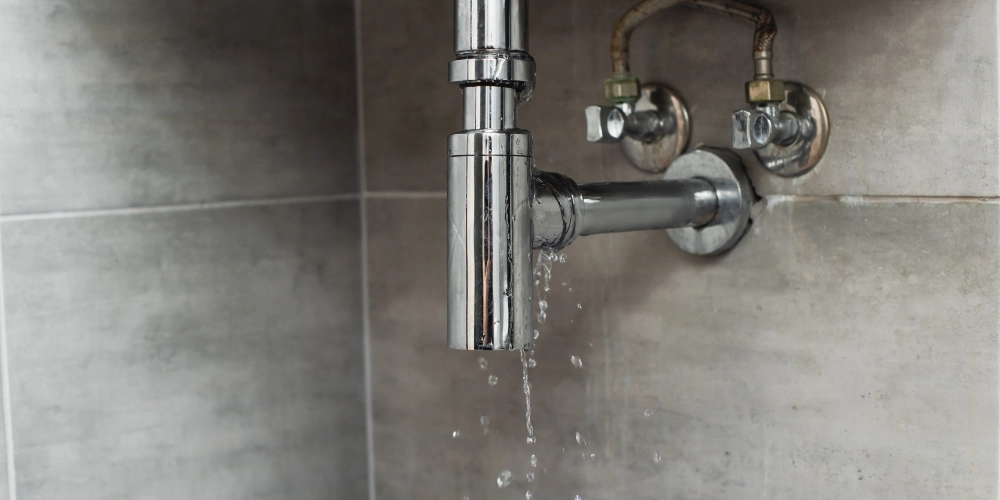Water is essential for life, but watching your money disappear down a slow, invisible drain is not.
Even small water leaks can silently cause significant problems, from higher water bills to damaged walls and floors. Catching leaks early can save you thousands in repairs and a lot of headaches down the road. Learn about the warning signs and what to do if you find a leak.
How to Detect Leaks
1. Check Your Water Meter
Testing your water meter is one of the easiest ways to determine if you have a hidden leak.
- Turn off all faucets, appliances, and sprinklers.
- Wait at least 30 minutes without using any water.
- Recheck your meter.
If the meter numbers have gone up, there’s water escaping somewhere. That’s your cue to start investigating where there is a leak in your system or to call a plumber.
Tip: Snap a quick photo of your water meter before and after to compare readings easily.
2. Drop in Water Pressure
Something is wrong if your shower suddenly feels weak or your kitchen faucet barely flows. A drop in water pressure often means water is leaking out of your pipes before reaching your fixtures.
Other possible reasons include:
- Clogged or corroded pipes
- A bad pressure-regulating valve
- Problems with your city’s water supply (ask neighbors if they have similar issues)
If you’ve ruled out those causes, a leak in your plumbing is likely to blame.
3. Mold, Mildew, or a Musty Smell
That “old house smell” you can’t place? It’s often a red flag for hidden moisture and could be the smell of expensive future repairs. Mold and mildew thrive in damp environments and are more than just unsightly; persistent dampness can lead to costly structural damage and health problems.
Look for:
- Musty odors, especially in enclosed spaces
- Mold or mildew under sinks or around tubs
- Damp walls, ceilings, or floors
Remember to check inside cabinets, closets, and crawl spaces. If mold returns after the leak is repaired and the mold is cleaned up, it’s time to call a professional for mold remediation.
4. Visible Water Damage
Water leaks leave clues. Look for:
- Peeling or bubbling paint or wallpaper
- Warped floors near sinks or tubs
- Sagging walls or ceilings
- Rust or corrosion on exposed pipes
- Yellow or brown stains on walls and ceilings
These aren’t cosmetic issues. They mean water has already found its way where it doesn’t belong.
5. Strange Sounds from Your Pipes
Your plumbing should be quiet. If you hear odd noises, pay attention to:
- Dripping: A sure sign of an active leak.
- Rattling or vibrations: Loose fittings that could turn into leaks.
- Running water sounds: A hidden leak is likely if all fixtures are off, but you still hear water.
Listen closely, especially at night when your home is quiet. Trust your ears!
6. Wet Spots or Lush Patches in the Yard
Leaks don’t just happen indoors. Outdoor plumbing can spring a leak, too.
Look for:
- Soggy patches or puddles when it hasn’t rained
- Bright green or unusually lush grass in one area
- Cracks forming in driveways or patios
A broken underground pipe or sprinkler line can waste hundreds of gallons of water daily.
What to Do If You Find a Leak
If you suspect or confirm a leak:
- Turn off your main water valve to stop the flow.
- Call a licensed plumber to locate and repair the problem.
- Document any damage with photos for insurance.
- Once the leak is fixed, thoroughly clean up mold or mildew to protect your health.
The faster you act, the less damage and cost you’ll face and the healthier your home will be.
Stay Proactive and Protect Your Home
Being a homeowner means monitoring your home’s health; your plumbing is no exception. Look for changes in your water bill, water pressure, or lingering musty odors. A little attention can prevent bigger problems later. When in doubt, it’s always cheaper to call a plumber now than a contractor later.
FAQs: Detecting Water Leaks
Q: What are the most common signs of water leaks?
Higher water bills, lower pressure, mold or mildew, water stains, and the sound of running water when no fixtures are on.
Q: How can I find a hidden leak myself?
Try the water meter test above or look for bubbling paint, damp spots, or musty smells.
Q: What should I do if I find a leak?
If it’s serious, turn off your home’s main water valve and call a professional plumber immediately.
Q: Can a small leak cause significant damage?
Yes. Even a slow drip can rot wood, encourage mold, and waste gallons of water over time.
Q: What causes leaks in the first place?
The usual culprits are aging pipes, corrosion, high water pressure, or worn-out seals.
Q: How can I prevent leaks?
Check visible pipes regularly, replace old fittings, and install a pressure regulator or smart water leak detector that automatically shuts off your water.
Q: How do I know if a leak is behind a wall?
Look for bubbling paint, damp drywall, or a musty odor, all signs of hidden moisture.
Q: Can tree roots damage water pipes?
Yes. Roots seek out moisture and can grow into cracked or loose pipe joints.
Q: How can I prevent tree root damage?
Plant trees with noninvasive roots at least 10–15 feet away from water lines or install a root barrier, a physical, underground wall, to prevent tree roots from growing into unwanted areas. Regular pipe inspections also help catch problems early.


